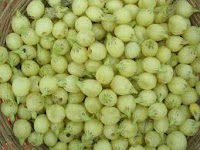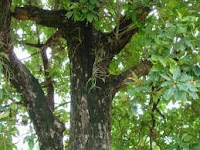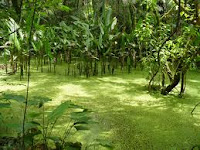MAHUA FLOWERS FROM THE BUTTER NUT TREE, MADHUA LONGIFOLIA
The Butter nut tree is native to the Indian subcontinent and grows in forests where the mahua flowers from it are collected from the ground by tribes’ people. The tree is a member of the Sapotaceae family and as such is related to the African Shea tree which produces the ingredient used in cosmetics, shea butter.
The tree is an evergreen or semi-evergreen and grows to between 17 and 20 metres high, with a dense, spreading canopy. It is now cultivated in warm climates for its oil-bearing seeds. However in parts of rural India
The flowers do not remain on the tree for long, and some say that they bloom at night and fall to the forest floor at dawn. They bloom between March and May, or at least this is their peak season, and the fruits ripen during the rainy season as do mangoes.
The flowers are dried after being collected from the forest floor and then sold to the state government in Orissa, for example, so that they can be made into an alcoholic drink. Unfortunately they are paid ridiculously low prices for their efforts and the flowers have been affected by climate change and are falling to the ground before they are mature because of unseasonable rain. They are also infested with red ants and these are not spotted until the flowers have been gathered, thus spoiling them.
The flowers and trees have religious significance for these people and there is a legend that Shiva gave the trees to people so that they could give the gods wine with their sacrifices of animals. Shiva called a parrot, a tiger and a boar, and turned them into mahua trees; that is why, so it is said, that if you drink a little of the wine made from these flowers you repeat things as a parrot does. If you drink a little more of the wine you start roaring like a tiger, until finally, when you have drunk a lot, you lounge around on the floor like a boar.
 |
| leaf buds |
The flowers were used in garlands when a princess chose a bridegroom and they are still part of religious ceremonies today, especially in central India India
In Sanskrit madhu means honey and this is how the tree got its botanical name, as the flowers have a strong aroma which is reportedly musky and heady. Tamils use the flowers as sweeteners when there is no sugar from sugar cane available, although they use this with caution as excessive use of the flowers is believed to prevent people thinking clearly and could lead to complete lunacy.
In traditional medicine, the flowers are used for a variety of purposes. An extract of the flowers is used for heart disease and to treat excessive vaginal discharge. This is also believed to be good for the eyes, TB, asthma, blood diseases, thirst and burning sensations. The flowers are also believed to be aphrodisiacs and to increase the quantity (but not necessarily the quality) of sperm.
The distilled juice of the flowers is used to get rid of parasitical internal worms, tonsillitis and bronchial problems. The juice of the flowers is used directly on the skin to treat skin problems, and as nasal drops it is used for sinusitis. A decoction of the flowers quenches thirst, and a general health tonic is made with powdered dried flowers mixed with ghee and honey. The flowers are also used to promote lactation in breast-feeding mothers, and to cure cystitis, while the expressed juice is also used to staunch the bleeding of wounds.
The flowers are not the only parts of the tree used, but the rest of the tree is dealt with in another post. Click here to read it.

































